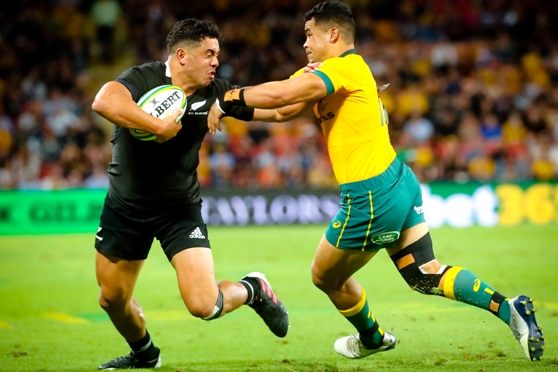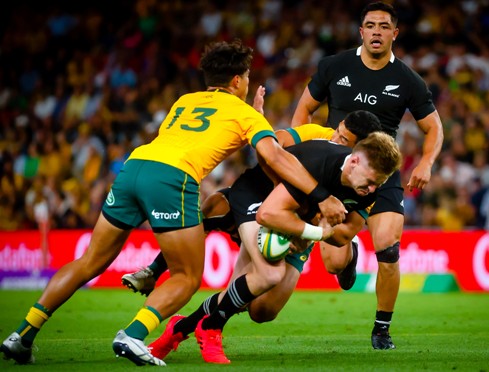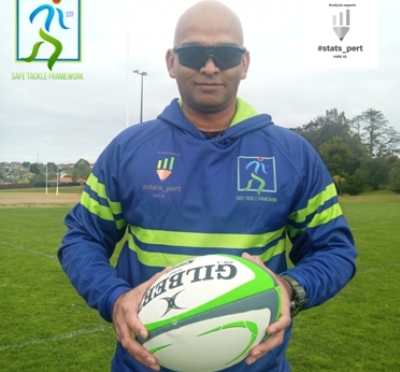By A Special Correspondent
COLOMBO -Two former Sri Lankan rugby stars based in New Zealand Ravindu Athukorala and Niranjan Ranasinghe have come up with an innovative concept called ‘Safe Tackle Framework’ to tackle the high incidence of red cards for what are deemed high tackles in rugby.
In May 2019 World Rugby unveiled a ‘Decision making Framework for High Tackles’ to be adhered to by referees. Under Law 9.11, the referee is always entitled to issue a red or yellow card for anything that they deem to be reckless or dangerous. Guidelines were introduced to improve consistency in application of sanctions by distinguishing between dangerous tackles that warrant a penalty, yellow card or red card.
The Auckland-based World Rugby Level 3 coaches have drawn up STF (Safe Tackle Framework) which will be trialled in a senior competition in New Zealand next season and hopefully, rolled out for an international competition and its implementation.
Pundits called for changes to rugby’s red-card system claiming that the Tri-Nations and Bledisloe Cup Test between Australia and New Zealand on November 7 was ruined when two players were sent off.
The Test in Brisbane ended in an upset 24-22 victory for the Wallabies but much of the post-match debate has centred on the red cards shown to Australia’s Lachie Swinton and New Zealand’s Ofa Tuungafasi.

Both were marched for reckless high tackles in the first half, with their absence contributing to a chaotic match that was thrilling to watch but upset some rugby purists.
“My Safe Tackle Framework (STF) has an ‘onfield orange card’ which will sort this mess out,” said Ravindu Athukorala, Director of Rugby at Manukau Rovers RFC in Auckland who is the founder and creator of the safety first and compliance-based tackle framework.
“The current World Rugby high tackle framework focuses on safety …rightly so. But it has its limitations and inflexibility in a fluid game of contact. Under the current framework, any direct contact to the head or neck area will be dealt with a card, most likely a red. My STF on-field framework suggests using an orange card. And in between, yellow and red. Only use red for outright and blatant foul play,” said the former Royal and CH&FC flanker known as ‘Boa Athu’ in New Zealand.
“Where there is contact to the head area, there will be plenty of instances when a tackler gets it wrong. Rather than ruin the contest, a common sense approach of an orange card – 10 minutes in bin with a post-match judicial hearing. This allows the game to go on without becoming a handicap. It looks after everyone – players, referees and most importantly fans,” said Athukorale.
Veterans such as former All Blacks John Kirwan and Christian Cullen, along with ex-Wallabies Phil Kearns and Tim Horan, have also claimed red cards were “ruining the spectacle” of the game.
Kirwan has suggested that, rather than being sent off, players who accidentally tackle high should be sin-binned for 10 minutes, then hauled before the judiciary to face bans.
However, All Blacks assistant coach John Plumtree said that, regardless of intent, the rules were designed to protect players and everyone on the field needed to follow them.
“We’ve got an obligation to ensure on the field that the players are safe,” he told reporters in a conference call.
“When we’re coaching the players, we’re always talking about body height and making sure that in contact we do the right thing and target the right areas.
“But at times, the player’s going to get that wrong under pressure and we saw that on the weekend.”
Ranasinghe and Athukorale spent more than two and half years to come up with the STF concept.
“Nira (Niranjan Ranasinghe) and I as coaches, did a lot of testing, re-testing, spoke to a lot of coaches, got a lot of feedback from players, referees. It’s a framework which helps everybody including spectators because the biggest disadvantage group in rugby are actually the spectators. If you keep penalising teams, there is no flow to the game and also it’s too confusing. There are some penalties which are blown which are very confusing. I have studied rugby pretty much all my adult and junior life. Even I can’t understand why some penalties are given. So you have to simplify it,” said Boa Athu, 41, who took up coaching early in his career.
“If you make any contact with shoulders or above or make contact to the head, it’s a minimum yellow or red card. We spent about three years to see how we can simplify this. We want to make sure everyone stays legal while at the same time we don’t lose effectiveness in the tackle,” explained Athukorala who has been domiciled in New Zealand since 2002.
“For me the biggest driver was these yellow cards. They were sanitizing the game. Rugby is a contact sport. People will get hurt. You are going to get a few broken bones. You might get a few knocks,” said Athukorala, a crash-tackling flanker who was member of the record-setting Royal Bradby side of 1998 and league champions CH&FC in 2000. Former Trinity and Kandy SC lock forward Niranjan Ranasinghe is perhaps the only Sri Lankan rugby star who has been both player and coach of a Premier rugby club in New Zealand.
“One attraction to rugby is the contact. People like to see big hits. My biggest issue was good big solid hits and tackles were being unfairly penalised because of this softening of the game. So rather than just complain of yellow cards and penalties as a coach I wanted to do something different. That was the main focus behind Safe Tackle Framework,” said Athukorala, who is Director of Rugby at Manukau Rovers RFC which is home of some great All Blacks such as Frank Bunce.
“We as coaches have to start coaching our players in a manner where they can stay compliant, legal and not disadvantage you because your tackle technique is not correct. It took us a good two and half years to develop this. We are almost at that stage where it will get rolled out,” said Athukorala, who aims to sit for the Educator course next year.

-ENCL


